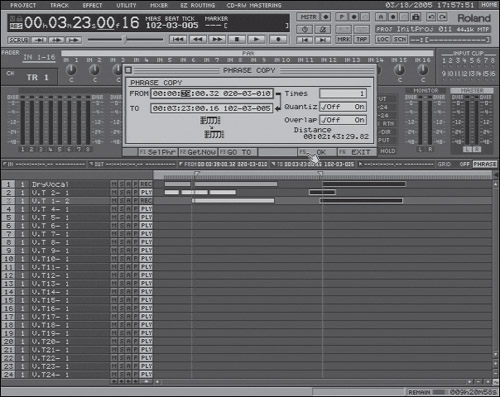Phrases and Regions
| < Day Day Up > |
Phrases and RegionsRegions and phrases both refer to sections of audio, but there are differences between them. RegionsA region may be made up of less than one complete phrase or encompass many phrases on multiple tracks. There may even be spaces between the phrases within a region. You set the beginning and ending points of a region via the IN and OUT buttons , respectively. PhrasesA phrase is one continuous segment of audio. When you edit phrases, you affect the entire phrase. You can make it shorter (or sometimes longer!) with Trim In and Trim Out operations. You can move or copy phrases in their entirety. You can manually split phrases into smaller sections or let the VS-2480 automatically divide a long phrase into several shorter ones. Only the phrases actually "touching" the current timeline are available for editing. Phrase Parameter EditingEach phrase has a name and can be programmed with its own playback level and fade in/out times, all independent of channel and fader settings. The Phrase Parameter edit dialog is accessed from the Track menu, as shown in Figure 17.1. Figure 17.1. Select Phrase Parameter from the Track menu You can only edit one phrase at a time. Both halves of stereo phrases must be adjusted manually. Figure 17.2 shows only one phrase available for editing. Figure 17.2. Select from the list of available phrases The Phrase Parameter screen default settings, shown in Figure 17.3, may be customized to create a special effect or to correct a problem with the phrase. The parameters you set for a phrase will be passed along to any sub-phrases created from the phrase. Figure 17.3. The Phrase Parameter screen default settings Take ManagerThe Take Manager is a text list of all the takes currently associated with the project. A take is the complete phrase of audio that is stored just after recording. Smaller phrases culled from this take do not themselves become takes. So long as any phrase culled from a take is included in the project, the entire take remains in the project. Even phrases that have been removed from the project during a phrase or region erase operation do not actually disappear from the hard disk, but stay listed in the Take Manager and may be recovered for use by the project. The Take Manager displays the name, start and end points, disk usage, and recording date of each take. The list may be sorted by name, history, or V-Track number. Moving Regions and PhrasesOne of the most common editing functions is the relocation of data in either regions or phrases. The VS-2480 has slightly different methods of moving or copying regions or phrases. When you are editing phrases, as shown in Figure 17.4, only the phrases currently intersecting the timeline are available. The length of data copied or moved is determined by the phrases themselves; consequently, only the FROM and TO points need to be assigned when working with phrases. To help visualize it, think to yourself, "I'm copying this entire phrase (or these entire phrases) FROM here TO there." Figure 17.4. Phrase selection After the phrase copy operation shown in Figure 17.5, the copied phrases are in the same positions relative to each other as the original phrases. Figure 17.5. Result of phrase copy operation Regions must have both a start point (IN) and end point (OUT). The IN and OUT points do not have to be visible on the screen to be relocated . This time, think, "I'm copying the region that starts at IN and ends at OUT, and I'm copying it FROM here TO there." Figure 17.6 shows a marked region and the result of the region copy operation. Figure 17.6. Result of region copy operation Choosing exactly how to move your data may depend on how the data was originally recorded. If your project was recorded to the VS-2480's internal metronome, the actual FROM and TO points can easily be set to exact measures, beats, and ticks . If your project was recorded from a drum machine that was not synchronized to the VS-2480, you may have to move data referenced from a kick drumbeat in measure 14 to a kick drumbeat in measure 38, for example. If you are replacing one bad bass note with a properly played one from somewhere else in the performance, you may move from the start of the "good" bass note to the start of the "bad" bass note. |
| < Day Day Up > |
- ERP Systems Impact on Organizations
- ERP System Acquisition: A Process Model and Results From an Austrian Survey
- Healthcare Information: From Administrative to Practice Databases
- A Hybrid Clustering Technique to Improve Patient Data Quality
- Development of Interactive Web Sites to Enhance Police/Community Relations


